| View previous topic :: View next topic |
| Author |
Message |
Pete Richards
Site Admin

Joined: 29 Dec 2008
Posts: 845
Location: Northeast Ohio



|
 Posted: Dec 23, 2016 12:57 Post subject: Re: Faden Quartz Crystals - (26) Posted: Dec 23, 2016 12:57 Post subject: Re: Faden Quartz Crystals - (26) |
|
|
| marco campos-venuti wrote: |
(Snip)
[1] Why the thread have traces of the fractures? A tiny crystal could repair easy completely.
[2] Why the overgrown crystal is always deformed? Deformation of the crystals means that they are formed in an unusual environment. But if the unusual situation responsible for the formation of the thread is ended at the moment of the overgrowth, there is no reason for the crystals to be always deformed, flat or distorted. In some case would be possible to have a normal quartz crystal with a faden thread inside, but this never happens.
[3] Now I want to try to think outside the box. Leaving aside the quartz and think about the fracture movement.
(snip)
A geologic mass of gneiss support an important quantity of stress and the release of this stress is responsible for the formation of the alpine fissures, but the growing of the fissure is made in a few steps or just in one single event, but is not a continuum.
Alpine Fissure-type veins are concentrated on folds in gneiss or granite and are a relatively surficial phenomenon. Deeper in the crust where rock behaviour is more ductile, the fissures are rapidly filled, forming pegmatites or quartz veins.
I suspect this is the end of the fracture-migration theory. R.I.P. |
(1) A tiny crystal might repair easily and completely, but it is also easy for a fractured crystal to heal with enough irregularity to trap fluids within the healed surface. At the scale of these bubble inclusions, the faden is not tiny, but is perhaps 10 to 30 times the diameter of the trapped fluid inclusions. Such bubble inclusions are extremely common wherever crystals have cracked and healed.
Incidentally, these inclusions are typically now filled with gas plus liquid, often plus one or more crystals. When heated enough, these combine into a single fluid that is taken to be identical to the (single-phase) fluid that was originally trapped. Such studies show that the inclusions formed - and therefore the faden was growing - at temperatures in the range of 300°C and under considerable pressure.
(2) The overgrowth crystals are distorted because they are nucleating along a linear, single crystal seed - the faden. This constitutes an “unusual environment”. They grow oriented in whatever direction the faden has, crystallographically, and typically this will not be one with a simple relationship to the crystallographic axes. This aspect of influenced crystal growth is observed in many different situations, not only in faden crystals. The calcite I showed in the other recent thread is but one example, though it is a magnificent one.
Faden quartz crystals CAN form with the faden parallel to the c axis, though this orientation would not be any more probable than any other. When this happens, the crystals have pretty much a “normal” habit, though they will be elongated more than a crystal grown in the same environment but not on a faden. I have seen a few such crystals. They are rare because any appreciable deviation of the faden from parallel to the c-axis will lead to some discernible distortion of the resultant faden crystal.
If a faden crystal could continue to grow freely - without running into other crystals or the vein walls - to a dimension of, say, several feet, it would gradually assume a normal shape, because the distortion caused by nucleation along the faden would become negligible compared to the size of the overall crystal.
(3) It is good to consider the geological conditions in which these crystals and their veins develop. I am not a geophysicist by any means. But I agree that the scenario you propose would not lead to faden development. However, my reading shows that others believe in a different mode for vein formation. Based on these writings, I believe your model for vein formation is the wrong one, one that would be appropriate for large-scale tectonics and basically at surface pressures and temperatures, where rocks are brittle. Several recent papers about alpine veins speak of microfracturing driven by hydrostatic pressures at elevated temperature and moderate depth, in a quiescent tectonic setting, under conditions where the rock is not ductile but not as rigid as at surface conditions. These are exactly the conditions that allow the development of faden. References are provided.
I should say that I am not alone in supporting the “crack-seal” hypothesis of faden development. I worked out the ideas myself while studying faden quartz I collected in Quebec, but then found that the basic ideas had been advanced in Russian in 1946, when I was 3 years old! The same paper was published in German translation in 1972. A more general treatment of fibrous crystals and rock deformation was advanced by Ramsay in 1980, and included in a textbook in the early 1980s. Perhaps my main contribution was providing a statement of these ideas in English.
The fact is that this idea has stood the test of time, and has become part of the standard model for Alpine vein mineralization. It has been accepted, hopefully with appropriate critical thought, by professionals in a number of related fields, and the basic ideas have been independently worked out at least twice. The “fracture-migration” hypothesis is alive and well!
I rest my case.
References, in chronological order:
Laemmlein, G.G. 1946. [On the origin of flat crystals with "white streaks”. Originally published in Russian in [Questions of Mineralogy, Geochemistry, and Petrography], Russian Academy of Science. Republished in 1972 in German translation (by B. Sta1der-Scherrer) with French summary.
Stalder·Scherrer, B. 1972. Über die Entstehung flacher Kristalle mit "weissen Streifen" [On the origin of flat crystals with white streaks]. Schweizer Strahler, 2,430-440.
Rykart, R. 1977. Zum Wachstum plattiger Quarze mit "Faden”. [On the growth of tabular quartz with faden]. Schweizer Strahler, 4, 209-221.
Ramsay, J.G. 1980. The crack-seal mechanism of rock deformation. Nature 284, 135-139.
Ramsay, J. G., and Huber, M.I. 1987. The Techniques of Modern Structural Geology. Volume 2: Folds and Fractures. Academic Press, London, 391 pages. See particularly Session 25.
Richards, R.P. 1990. The origin of Fadenquartz. Mineralogical Record 21: 191-201.
Wagner, T. and Cook, N.J. 2000. Late-orogenic alpine-type (apatite)-quartz fissure vein mineralization in the Rheinisches Schiefergebirge, NW Germany: mineralogy, formation conditions and lateral-secretionary origin. Mineralogical Magazine 64(3): 539-560.
Cesare, B., Poletti, E., Bioron, M-C., and Cathelinea, M. 2001. Alpine metamorphism and veining in the Zentralgneis Complex of the SW Tauern Window: a model of fluid-rock interactions based on fluid inclusions. Tectonophysics 336: 121-136.
Akhavan, A. (2012). The quartz page. https://www.quartzpage.de/about.html, accessed December 23, 2016.
_________________
Collecting and studying crystals with interesting habits, twinning, and epitaxy |
|
| Back to top |
|
 |
marco campos-venuti

Joined: 09 Apr 2014
Posts: 227
Location: Sevilla



|
 Posted: Dec 23, 2016 14:30 Post subject: Re: Faden Quartz Crystals - (26) Posted: Dec 23, 2016 14:30 Post subject: Re: Faden Quartz Crystals - (26) |
|
|
In any case, I learned a lot during this discussion and I hope more peoples add to the thread (double meaning joke!!).
I'm still convinced that quartz faden crystals grows over a preexisting thread, that is the second part of your two step model. So we can say that we are 50% in agreement.
I have no idea what is the preexisting thread and I don't have my own theory, but I'm sure more investigation is necessary to clarify the mechanism, also in the case you are right.
In your thin section cross-polarized picture it is possible to observe 2 trends in the thread. One is many short lines perpendicular to the thread. The second is perpendicular to the first and consists in few lines along the thread direction. While the first are the supposed fractures, the second can be a relict of the preexisting thread. Veil inclusions in crystals composed of many little voids with water are a common feature and are formed in a variety of ways, between others fractures, growing defeats or pseudomorphose after some preexisting material. Between all, the only one I think can not be finely repeated is the case of a fracture.
A pseudomorphose could be an alternative.
Just as an example I want to show you something. The picture 1 show a quartz with a strange inclusion. It is not a real thread, but it remember one. And is made by repeated lines. Observing a big number of specimens I can related the millefeuille structure (as I called it) with the pseudomorphose of an included tourmaline crystal. Picture 2 is a less advanced case and picture 3 is a quartz with a true tourmaline inside.
In the diagram we have 1) tourmaline crystallizes in a pegmatitic environment of high temperature and high pressure. 2) tourmaline is altered in hydrothermal high temperature environment. 3) tourmaline is the feeding crystal for the overgrowth of an epitactic quartz (the hypothesis is about an epitaxy with constant angle of around 23,5°). 4) included tourmaline is transformed into chlorite or Muscovite (a typical alteration process of the tourmaline) and then into quartz, giving the millefeuille structure.
I'm not sure about the physics of all the steps of the process, but there are many evidences that the sequence is as described.
| Mineral: | 1 - quartz with millefeuille inclusion |
| Locality: | | Brazil |  |
|
| Dimensions: | 44 mm |
| Description: |
|
| Viewed: |
59487 Time(s) |
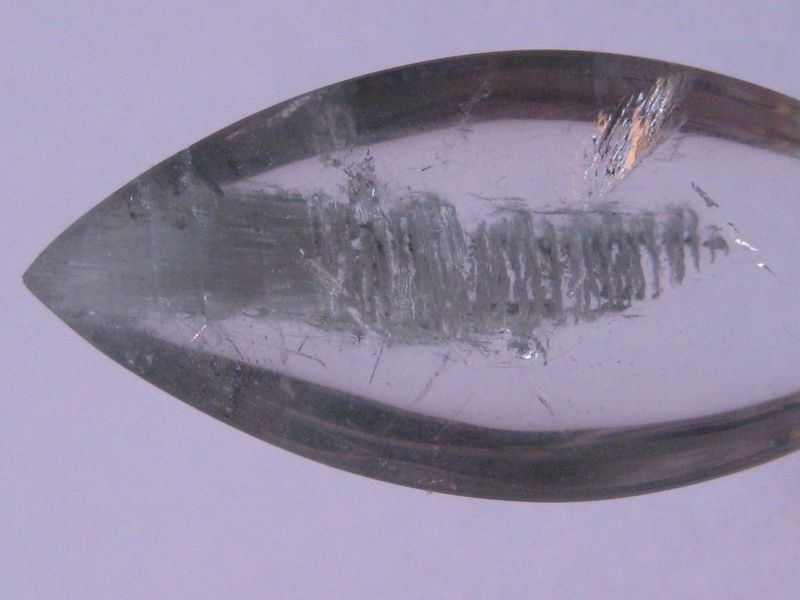
|
| Mineral: | 2 - quartz with millefeuille chlorite phantom |
| Locality: | | Brazil |  |
|
| Dimensions: | 40 mm |
| Description: |
|
| Viewed: |
59475 Time(s) |
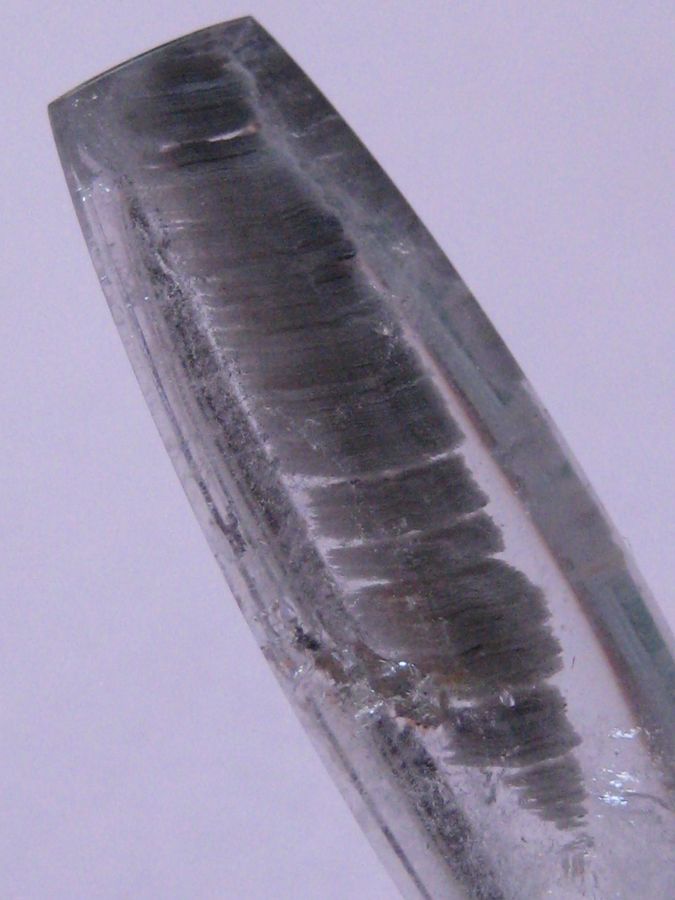
|
| Mineral: | 3 - quartz with tourmaline crystal inclusion |
| Locality: | | Araçuaí, Vale do Jequitinhonha, Minas Gerais, Brazil |  |
|
| Dimensions: | 10 cm |
| Description: |
Morro Redondo, Aracuai, Minas Gerais, Brazil
The included tourmaline crystal has been analyzed and no tourmaline remain, being the tourmaline completely replaced by quartz. |
|
| Viewed: |
59498 Time(s) |
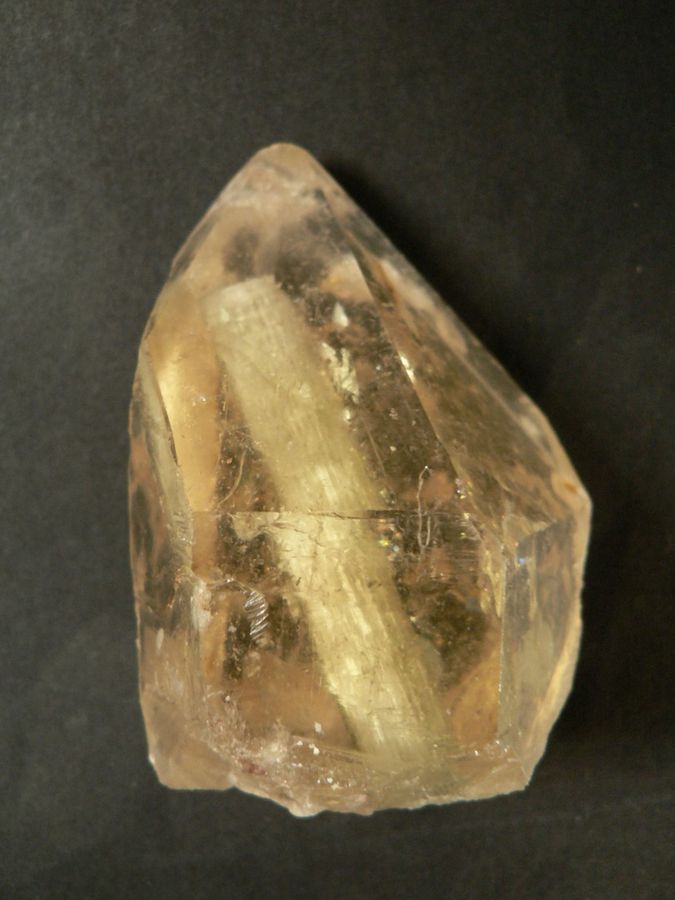
|
| Mineral: | Diagram of the formation of the millefeuille structure |
| Description: |
|
| Viewed: |
59519 Time(s) |

|
|
|
| Back to top |
|
 |
Roger Warin

Joined: 23 Jan 2013
Posts: 1233



|
 Posted: Dec 23, 2016 15:40 Post subject: Re: Faden Quartz Crystals - (26) Posted: Dec 23, 2016 15:40 Post subject: Re: Faden Quartz Crystals - (26) |
|
|
Hi Pete, Marco,
Excuse me for participating in a discussion of such a level, because I am not competent but only curious. However, I wonder if certain factors are not forgotten, like the variation of coefficients of dilation with temperature. They sometimes change sign. This would occur in an anisotropic crystal.
Could this not cause cracks?
These voids could purify the growing crystal by capturing internal fluids in the hot crystal, as if it was an exsolution.
Can we not remember the helical dislocations of beryl?
|
|
| Back to top |
|
 |
Roger Warin

Joined: 23 Jan 2013
Posts: 1233



|
 Posted: Dec 30, 2016 00:23 Post subject: Re: Faden Quartz Crystals - (26) Posted: Dec 30, 2016 00:23 Post subject: Re: Faden Quartz Crystals - (26) |
|
|
The origin of the Faden quartz.
In 1990, I was happy to read Rykart's interpretation. Over time, doubt has been insinuated especially after observing an increasing number of specimens of Faden quartz. Gwindels themselves can have a Faden.
I greatly appreciated the theses defended by Pete and Marco, but I do not think they adequately describe the initial situation that will give rise to the Faden quartz.
Here is how I conceive the phenomenon.
All the Fadenquarz do appear in a vug, which amounts to saying that they crystallize in an almost closed system, as in a box. I have difficulty in conceiving the growth of an initiating filament of the thread in the void of the crevice, or even in a solution. I suggest that this linear ribbon can be sustained in the initial medium. This environment would be a supersaturated gel of non-crystalline silica (in fact polymerized Si(OH)4). This silica gel can withstand temperatures up to 300 ° C without losing water.
It is this silica gel environment that I choose as phase that will crystallize.
This factor which breaks the metastable equilibrium of the supersaturated gel could be correlated with a sudden as well as brutal retraction initiated by a shock.
Under the effect of an adiabatic expansion (rupture of the box), a silica thread does appear suddenly, as if a lightning bolt had crossed the silica gel. This triggering of nano-crystals would be done in a straight line, although curvature effects are possible.
This factor which breaks the metastable equilibrium of the supersaturated gel could be correlated with a sudden as well as brutal retraction initiated by a shock.
The velocity of this primordial crystallization is great, incorporating bubbles of fluids in the blank of small crystal domains. In practice, one would have a series of lattices substantially aligned, since the flash of crystallization would not have allowed a position of equilibrium between all these domains.
Then, the normal growth of the crystal (or the crystal sequence) can resume normally, the initial stresses having disappeared.
The value of this assumption lies in the fact that the linear ribbon germ is supported by the gel and does not float in a vacuum.
This environmental context being proposed, we can think of other mechanisms of initiation of crystallization. Thus, the creation of a hydrodynamic cavitation makes it possible to cause nucleation and the direct production of crystals.
This cavitation could be caused by the sudden drop in pressure, by a wave or by any impurity which strikes the supersaturated silica gel. Let us not forget also that the collapse of a vacuum bubble in a liquid creates a strong localized shock wave. The Faden abandons a thread of small cavitation bubbles. Even ultrasounds are likely to initiate crystallization but I do not think they exist in this context.
In fact my main hypothesis lies in the nature of the initial medium enclosed in a pocket that opens suddenly.
|
|
| Back to top |
|
 |
marco campos-venuti

Joined: 09 Apr 2014
Posts: 227
Location: Sevilla



|
 Posted: Dec 30, 2016 05:42 Post subject: Re: Faden Quartz Crystals - (26) Posted: Dec 30, 2016 05:42 Post subject: Re: Faden Quartz Crystals - (26) |
|
|
Hi Roger,
the gel context is exactly what I was thinking when I supposed a chalcedony thread. The polymerization starts from the wall rock in the form of curved chains. Is like an agate, but in a different geological context.
|
|
| Back to top |
|
 |
Harjo

Joined: 04 Nov 2009
Posts: 32
Location: Vessem



|
 Posted: Dec 30, 2016 17:53 Post subject: Re: Faden Quartz Crystals - (26) Posted: Dec 30, 2016 17:53 Post subject: Re: Faden Quartz Crystals - (26) |
|
|
Just as an illustration...here is a nice curved fadenquartz from Bierghes, Belgium.
I found many curved fadenquartzes in one specific cleft, hardly any in many other nearby clefts. The curvature of the faden most likely depended on the direction in which the specific cleft opened but it puzzles me why the curved fadens were restricted to merely one cleft.
We collected them from a cleft in a series if typical Scherklüfte, schearing clefts, which tend to form in rows of similarly orientated clefts.
| Mineral: | Quartz (variety faden) |
| Locality: | | Quenast, Rebecq, Nivelles District, Walloon Brabant Province, Wallonne Region, Belgium |  |
|
| Dimensions: | 13.5 cm |
| Description: |
|
| Viewed: |
35622 Time(s) |
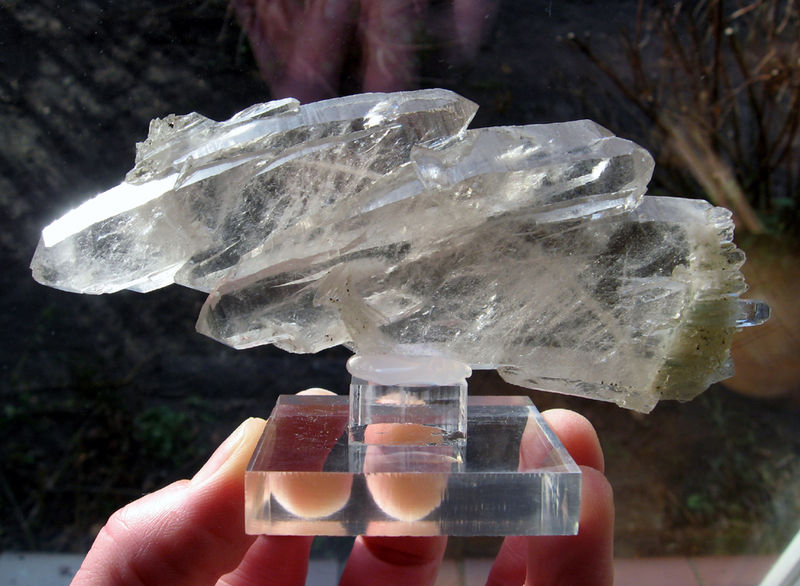
|
|
|
| Back to top |
|
 |
Harjo

Joined: 04 Nov 2009
Posts: 32
Location: Vessem



|
 Posted: Dec 30, 2016 17:54 Post subject: Re: Faden Quartz Crystals - (26) Posted: Dec 30, 2016 17:54 Post subject: Re: Faden Quartz Crystals - (26) |
|
|
Another quite interesting fadenquartz from the same locality
| Mineral: | Quartz (variety faden) |
| Locality: | | Quenast, Rebecq, Nivelles District, Walloon Brabant Province, Wallonne Region, Belgium |  |
|
| Dimensions: | 3cm |
| Description: |
|
| Viewed: |
35638 Time(s) |
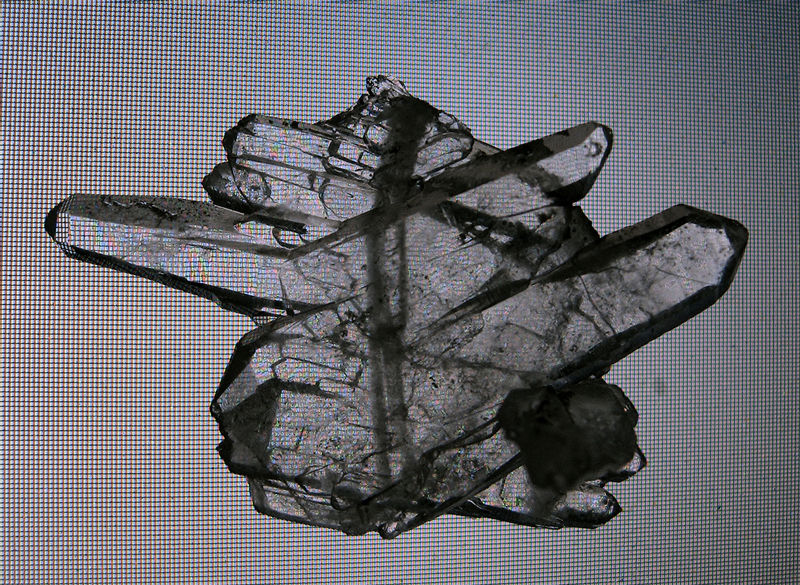
|
|
|
| Back to top |
|
 |
alfredo
Site Admin

Joined: 30 Jan 2008
Posts: 1012



|
 Posted: Dec 30, 2016 17:56 Post subject: Re: Faden Quartz Crystals - (26) Posted: Dec 30, 2016 17:56 Post subject: Re: Faden Quartz Crystals - (26) |
|
|
| I think it is mistaken to think of a long "thread" growing across a cavity, because it starts out as an extremely short thread, being just the "healing" process between the 2 parts of a cracked quartz grain in which, of course, the two halves of the broken grain have the same crystallographic orientation. As the crack continues to widen, the healing process continues and the thread gets longer. All that is necessary is for the crack to widen at a slower rate than the quartz can reheal, which would be not unexpected in an alpine tectonic setting.
|
|
| Back to top |
|
 |
Harjo

Joined: 04 Nov 2009
Posts: 32
Location: Vessem



|
 Posted: Dec 30, 2016 18:09 Post subject: Re: Faden Quartz Crystals - (26) Posted: Dec 30, 2016 18:09 Post subject: Re: Faden Quartz Crystals - (26) |
|
|
Exactly, and while expanding the fluids present cause quartz crystals to grow on the row of quartz grains, just up to the point of saturation. The orientation of the faden towards the c-axis as illustrated in the above drawings can be explained by the orientation of the grain (its crystal lattice)
But explain why only one cleft in a series of concordant shearing clefts produced the bent faden ;-)
Here's a link to a video showing another Bierghes faden peculiarity. It shows a fadenquartz which is ordinary on one side, but the single faden "sprouted" two differently orientated parallel rows of crystals on the other side. I show the video because the peculiarity doesn't come across on a photo: https://www.youtube.com/watch?v=wnNuvfh_bV8
|
|
| Back to top |
|
 |
Roger Warin

Joined: 23 Jan 2013
Posts: 1233



|
 Posted: Jan 08, 2017 03:05 Post subject: Re: Faden Quartz Crystals - (26) Posted: Jan 08, 2017 03:05 Post subject: Re: Faden Quartz Crystals - (26) |
|
|
Hi Alfredo,
I persist in the error ... I do not believe in healing process, but in an almost linear flash in a phase of saturated silica gel, set between the two walls of the cavity. The importance of silica gels in geology is underestimated
|
|
| Back to top |
|
 |
Roger Warin

Joined: 23 Jan 2013
Posts: 1233



|
 Posted: Jan 08, 2017 03:54 Post subject: Re: Faden Quartz Crystals - (26) Posted: Jan 08, 2017 03:54 Post subject: Re: Faden Quartz Crystals - (26) |
|
|
Hi,
John Kashuba (Oregon) sent me a lot of photos of Faden quartz in thin sections. To have a certain depth, he chose a thickness of 100 μm instead of 30 μm normally. Faden TS are observed in oblique incident light.
| Mineral: | Faden quartz |
| Description: |
| Faden for sectioning. © J.K. |
|
| Viewed: |
34848 Time(s) |
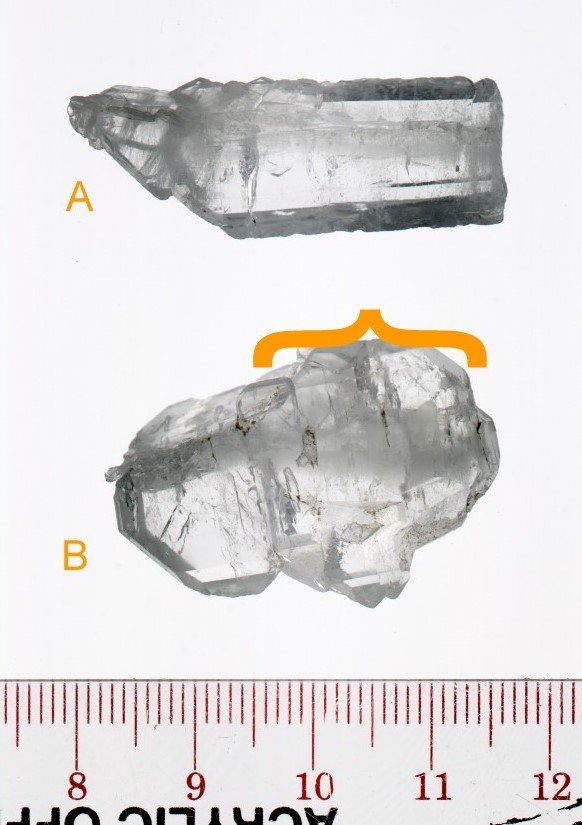
|
| Mineral: | Faden quartz |
| Description: |
Quartz faden lateral section T~100um, FOV=0.53mm wide P1200.
© John Kashuba. |
|
| Viewed: |
34804 Time(s) |
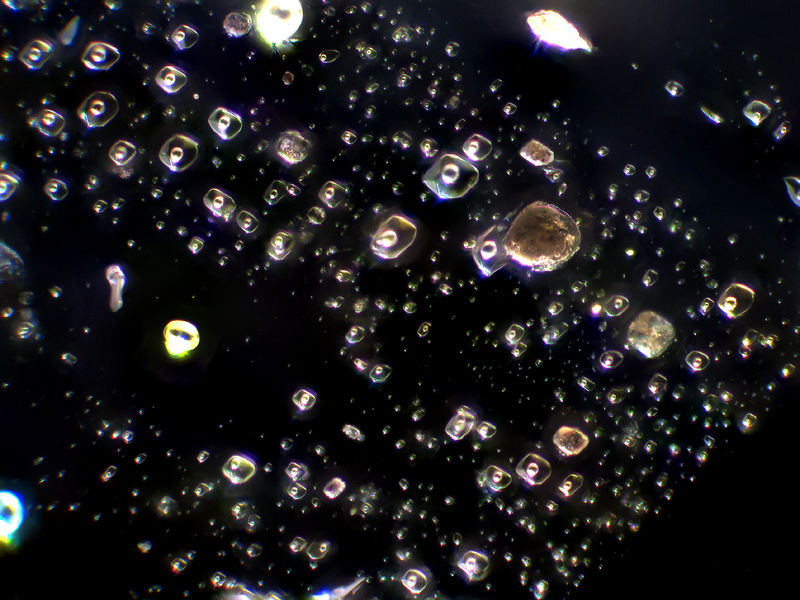
|
| Mineral: | Faden quartz |
| Description: |
Quartz faden lateral section T~100um, FOV=3.7mm wideP1200.
© John Kashuba. |
|
| Viewed: |
34875 Time(s) |
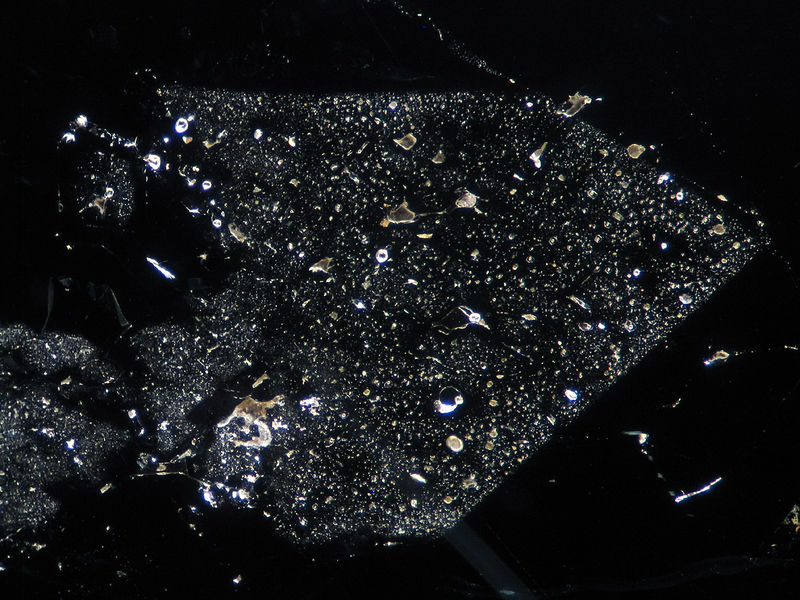
|
|
|
| Back to top |
|
 |
Roger Warin

Joined: 23 Jan 2013
Posts: 1233



|
 Posted: Jan 08, 2017 04:01 Post subject: Re: Faden Quartz Crystals - (26) Posted: Jan 08, 2017 04:01 Post subject: Re: Faden Quartz Crystals - (26) |
|
|
In conclusion, John Kashuba said to me:
“The inclusions appear to be in flat planes across the entire Faden and at right angle to the length of the Faden so it appears we cannot invoke an "inclusions during episodic skeletal crystallization" mechanism. Further, I have found cross-cutting planes of inclusions that beg to be seen as off-axis breaks.”
Many thanks John.
Note: only the inclusions are visible, not the crystal
The growth seems discontinuous creating multiple microcrystals
| Mineral: | Faden |
| Description: |
| Quartz faden running left-right, curtains of defects viewed edge-on, FOV=0.44mm wide P1200x900. Tich section (T~100µm) in oblique incident light. © John Kashuba. |
|
| Viewed: |
34818 Time(s) |
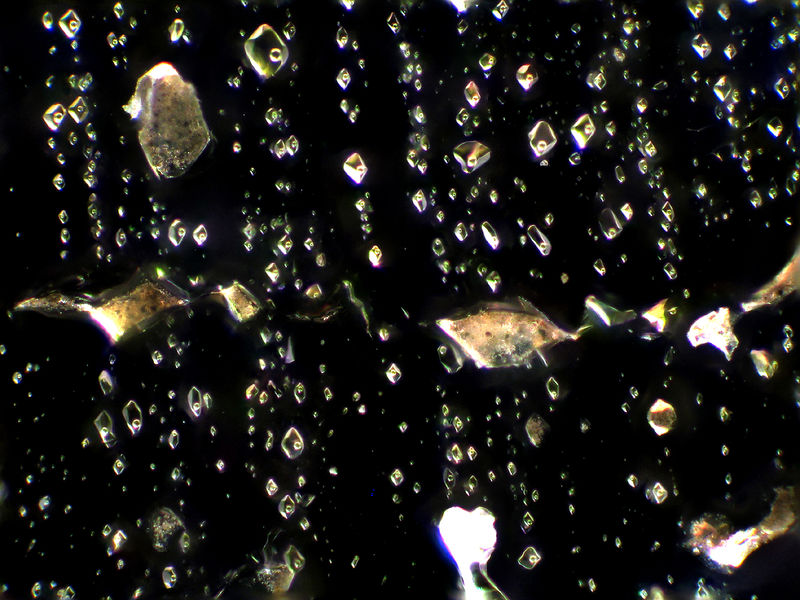
|
|
|
| Back to top |
|
 |
marco campos-venuti

Joined: 09 Apr 2014
Posts: 227
Location: Sevilla



|
 Posted: Jan 08, 2017 09:29 Post subject: Re: Faden Quartz Crystals - (26) Posted: Jan 08, 2017 09:29 Post subject: Re: Faden Quartz Crystals - (26) |
|
|
Your video is private.
|
|
| Back to top |
|
 |
Pierre Joubert
Joined: 09 Mar 2012
Posts: 1605
Location: Western Cape



|
 Posted: Jan 08, 2017 12:57 Post subject: Re: Faden Quartz Crystals - (26) Posted: Jan 08, 2017 12:57 Post subject: Re: Faden Quartz Crystals - (26) |
|
|
The last photograph and one of the others, looks like microscopic negative crystals with water.
_________________
Pierre Joubert
'The tree of silence bears the fruit of peace. ' |
|
| Back to top |
|
 |
Pete Richards
Site Admin

Joined: 29 Dec 2008
Posts: 845
Location: Northeast Ohio



|
 Posted: Jan 08, 2017 13:23 Post subject: Re: Faden Quartz Crystals - (26) Posted: Jan 08, 2017 13:23 Post subject: Re: Faden Quartz Crystals - (26) |
|
|
| Pierre Joubert wrote: | | The last photograph and one of the others, looks like microscopic negative crystals with water. |
That's exactly what they are, water with a gas bubble.
_________________
Collecting and studying crystals with interesting habits, twinning, and epitaxy |
|
| Back to top |
|
 |
|





